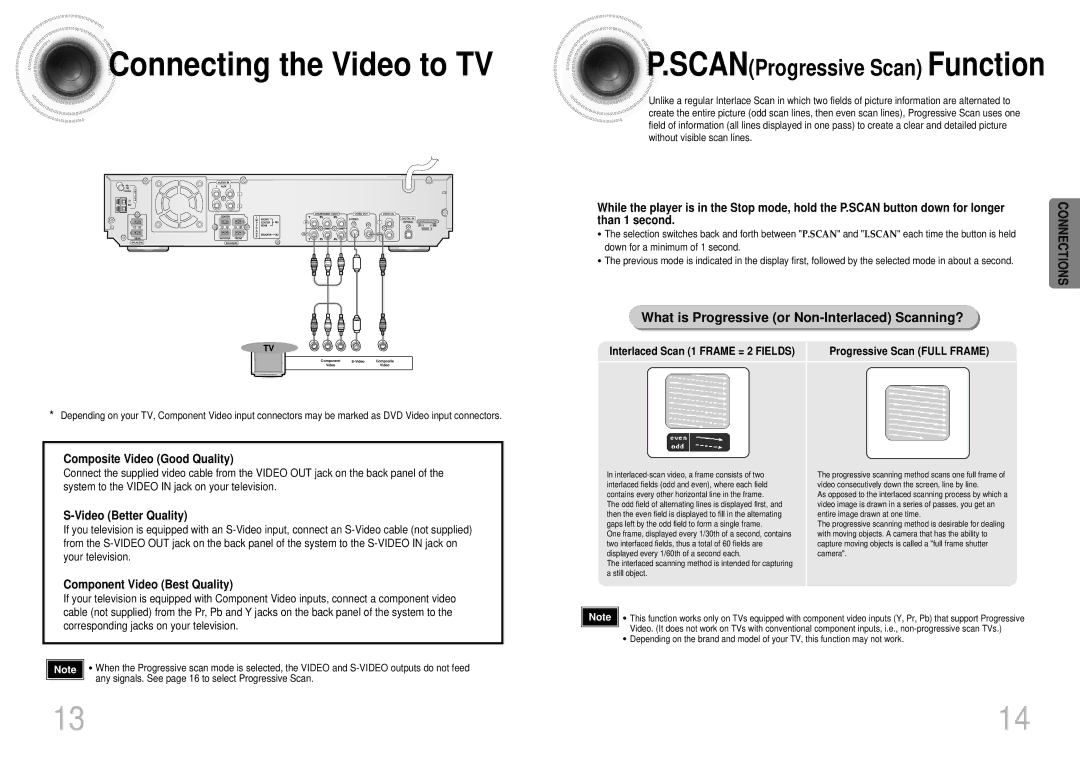



 Connecting
Connecting the Video to TV
the Video to TV
VOLTAGE SELECTOR
TV
Component | Composite | |
Video |
| Video |
*Depending on your TV, Component Video input connectors may be marked as DVD Video input connectors.
Composite Video (Good Quality)
Connect the supplied video cable from the VIDEO OUT jack on the back panel of the system to the VIDEO IN jack on your television.
S-Video (Better Quality)
If you television is equipped with an
Component Video (Best Quality)
If your television is equipped with Component Video inputs, connect a component video cable (not supplied) from the Pr, Pb and Y jacks on the back panel of the system to the corresponding jacks on your television.
Note • When the Progressive scan mode is selected, the VIDEO and ![]() any signals. See page 16 to select Progressive Scan.
any signals. See page 16 to select Progressive Scan.



 P.SCAN
P.SCAN (Progressive Scan) Function
(Progressive Scan) Function
Unlike a regular Interlace Scan in which two fields of picture information are alternated to create the entire picture (odd scan lines, then even scan lines), Progressive Scan uses one field of information (all lines displayed in one pass) to create a clear and detailed picture without visible scan lines.
While the player is in the Stop mode, hold the P.SCAN button down for longer | CONNECTIONS |
than 1 second. |
|
• The selection switches back and forth between "P.SCAN" and "I.SCAN" each time the button is held |
|
down for a minimum of 1 second. |
|
• The previous mode is indicated in the display first, followed by the selected mode in about a second. |
|
What is Progressive (or Non-Interlaced) Scanning?
Interlaced Scan (1 FRAME = 2 FIELDS) | Progressive Scan (FULL FRAME) |
In | The progressive scanning method scans one full frame of |
interlaced fields (odd and even), where each field | video consecutively down the screen, line by line. |
contains every other horizontal line in the frame. | As opposed to the interlaced scanning process by which a |
The odd field of alternating lines is displayed first, and | video image is drawn in a series of passes, you get an |
then the even field is displayed to fill in the alternating | entire image drawn at one time. |
gaps left by the odd field to form a single frame. | The progressive scanning method is desirable for dealing |
One frame, displayed every 1/30th of a second, contains | with moving objects. A camera that has the ability to |
two interfaced fields, thus a total of 60 fields are | capture moving objects is called a "full frame shutter |
displayed every 1/60th of a second each. | camera". |
The interlaced scanning method is intended for capturing |
|
a still object. |
|
Note | • | This function works only on TVs equipped with component video inputs (Y, Pr, Pb) that support Progressive |
|
| Video. (It does not work on TVs with conventional component inputs, i.e., |
•Depending on the brand and model of your TV, this function may not work.
13 | 14 |
